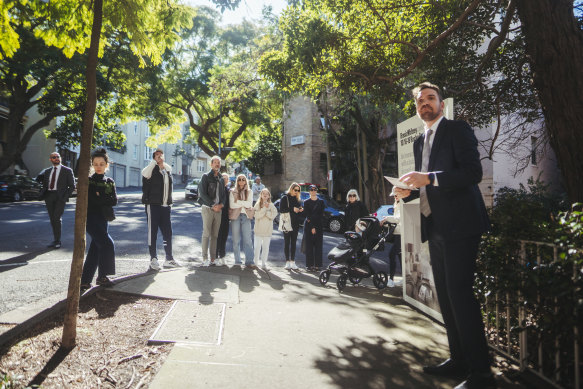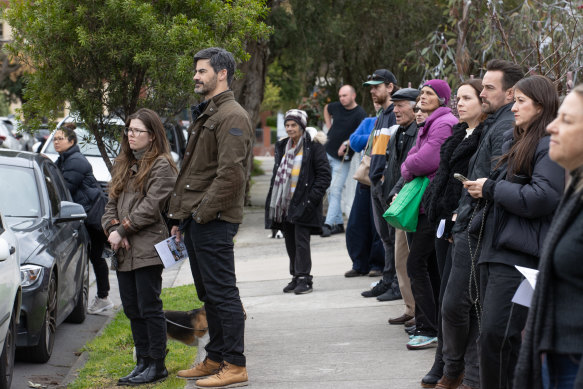Suburbs where families can’t afford to pay the mortgage, and can’t afford not to
Home owners facing the highest levels of mortgage stress who decide to sell their home and rent instead would face a tight local rental market, new analysis shows.
In a handful of outer suburbs, at least one in 50 borrowers are behind on their home loan repayments. But in the same areas, the cost of renting is higher than a year ago.

Higher interest rates are putting borrowers under pressure.Credit: Dion Georgopoulos
Most home owners have managed to cut spending and keep up with higher home loan repayments in the wake of 13 interest rate rises from the Reserve Bank to tame inflation, but borrowers hoping for relief are unlikely to get a rate cut for months yet.
The share of home borrowers at least 30 days behind on their mortgages slipped to 0.95 per cent in June, on S&P Global Ratings analysis of prime residential mortgage-backed securities, slipping from 0.98 per cent in the first quarter.
This remains historically low, but the ratings agency expects more households to fall behind as more workers lose their jobs, although the level of increase is expected to be moderate. Many households have so far kept their jobs, drawn down on lockdown-era savings buffers, and refinanced at competitive rates.
Arrears have increased most over the past year in NSW and Victoria, where property prices are moderating, and have declined in Queensland and Western Australia, where property markets have been stronger – helping borrowers refinance or voluntarily sell.
By postcode, the highest proportion of loans in arrears was Casula in western Sydney at 3.16 per cent or about one in every 32 borrowers falling behind. It was followed by Craigieburn in northern Melbourne at 2.81 per cent.
Households are also under stress in Blacktown and Camden in western Sydney and Doreen in northern Melbourne and Burnside in Melbourne’s west, as well as Advancetown on the Gold Coast and Armadale in Perth’s outer south-east, all of which have at least 2 per cent of loans in arrears.
S&P Global Ratings director Erin Kitson said pre-pandemic, the postcodes under pressure were largely in Western Australia, where the property market had a stretch of weakness.
“What we’ve seen a lot more of is outer postcodes in Sydney and Melbourne and that is going to reflect higher levels of borrowing in those areas because prices are higher,” she said.
“Those areas are where you’re more likely to see first home owners … these are people earlier in their careers, maybe not the same level of savings.”
Separate figures from Domain show rents have risen in each of these suburbs for which data is available over the past year.
In Blacktown, house rents have risen 18 per cent over the year to June, while unit rents are 20.9 per cent higher. Houses rents in Casula rose 14 per cent and Camden by 10.9 per cent.
In Victoria, Craigieburn house rents are 16.3 per cent higher than a year ago while Doreen (14 per cent) and Burnside (13.3 per cent) also rose.
The rising costs would reduce the options for someone struggling to pay their mortgage.
“That’s very difficult, isn’t it, to go and rent. Finding a rental property when vacancy rates are low is difficult,” Kitson said.
“The first port of call for an owner-occupier would be trying to get a hardship application going with the lender just given the difficulties in not just maintaining a mortgage, but the low vacancies and the high rental prices. It’s a very pressing problem.”
Canstar data insights director Sally Tindall said higher local rents pose a challenge to home owners falling behind and considering selling and renting elsewhere.

Buyers were mostly keeping up, but some are falling behind.Credit: Simon Schluter
“This does limit their options when people feel like they’re [caught between] a rock and a hard place,” she said.
“In areas where the rental market is increasingly tight, it might mean it’s a more difficult option for them.”
She said struggling borrowers should call their bank and ask for a rate cut. If that is not enough, they should ask their bank about their repayment options, and call the National Debt Helpline for free advice from a financial counsellor.
UNSW senior research fellow in the City Futures Research Centre Chris Martin called for a national housing plan that took account of systemic risks from higher interest rates.
One option could be a shared equity scheme in which government took an ownership stake in homes of the highest-risk borrowers, relieving some of the interest costs, he said.
“It’s a problem that we haven’t had for some time, the problem of the serviceability stress. We’ve largely avoided that in Australia by removing low and moderate incomes from access to home ownership over the last couple of decades,” he said.
“But now because interest rates have risen much more than people expected that is re-emerging as a problem.”